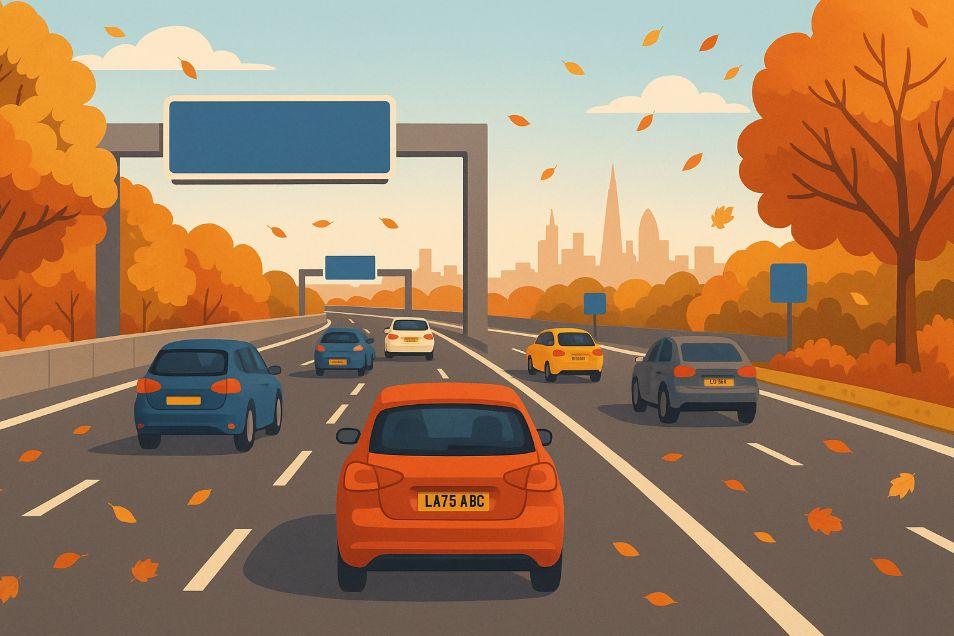Each October, the UK’s vehicle registration system undergoes a scheduled change, and in 2025, the DVLA will introduce the new “75” plate. While to many it might just seem like a routine update, these number plate changes have broader implications from influencing car sales to affecting insurance premiums and road compliance.
For drivers across London and the wider UK, understanding the DVLA number plate changes in October is essential. This guide explains what’s changing, why it matters, and how drivers can prepare for the latest developments in vehicle registration.
What Are the DVLA Number Plate Changes in October 2025?

In October 2025, the DVLA will launch the “75” registration plate, marking the second update of the year following the March release of the “25” plate. This twice-yearly update system, established in 2001, helps manage vehicle registrations and allows drivers and authorities to quickly identify when a vehicle was first registered.
The new “75” plates will be assigned to all vehicles first registered from 1st October 2025 onward. The format of the plates remains consistent: the first two letters represent the local DVLA office, the two-digit number now “75” signifies the period of registration, and the last three letters are randomised to ensure uniqueness. For example, a new vehicle registered in London may display something like LA75 RKU.
This change is not just symbolic it helps maintain accurate registration records and supports law enforcement and road safety efforts across the country.
What Is New with the 75-Plate Release from DVLA?
While the overall format of the registration plate remains unchanged, the introduction of the “75” identifier signifies the latest group of vehicles entering UK roads. For many car buyers, particularly those considering brand-new models, the release of a new plate can influence the timing of their purchase.
This new registration code marks vehicles registered between 1st September 2025 and the end of February 2026. Dealerships often see a significant boost in sales around this time, as consumers prefer to own a vehicle that appears as new as possible for resale value and prestige.
In addition, certain government data systems and car valuation tools rely on these biannual plate updates to assess the age and worth of a vehicle.
So, while the technical specifications may not change with the “75” plate, its release has a noticeable impact on consumer behaviour, industry practices, and the perception of value.
Why Does the UK Have Biannual Number Plate Updates?
The UK’s system of releasing two number plate series each year was designed to balance consumer demand and industry logistics. Historically, vehicle registrations were concentrated at a single point in the year, leading to administrative pressure and unpredictable market trends.
The current system, with plates issued in March and September (reflected as “25” and “75” in 2025), helps create a steady rhythm in the car market. This setup also brings transparency to the used car market. A vehicle’s plate immediately indicates its age, which helps buyers and dealers make better-informed decisions.
Additionally, enforcement systems like ANPR (Automatic Number Plate Recognition) cameras benefit from this clarity, making it easier to track vehicles for taxation, insurance, and compliance purposes.
In essence, the biannual update is a regulatory tool and economic stimulator, offering predictable moments in the year that drive both compliance and commerce.
How Do the October DVLA Number Plate Changes Affect UK Drivers?

For most drivers, the introduction of the “75” plate may seem minor, but it can influence various aspects of car ownership. New car buyers often choose to wait for the October release to ensure their vehicle carries the latest registration. This not only helps with maintaining higher resale value but also enhances the vehicle’s perceived age when selling in future.
In London, the impact can be more pronounced due to initiatives like the Ultra Low Emission Zone (ULEZ), which rely on accurate registration details. Vehicles with newer plates are more likely to meet modern emissions standards, avoiding additional charges.
Furthermore, insurance providers sometimes factor in registration periods when assessing premiums, associating newer plates with lower risk and better safety features. On the flip side, drivers looking to sell vehicles with older plates around this time may face reduced demand, as buyers lean towards newer registrations.
What Number Plate Regulation Changes Should Drivers Be Aware of in 2025?
Beyond the visual update to the registration number, October 2025 brings in stricter regulations for how number plates are manufactured and displayed. The DVLA has introduced tighter rules concerning legibility and durability, aiming to improve road safety and vehicle tracking.
Plates must now meet enhanced reflectivity standards, ensuring better visibility during night-time and poor weather conditions. Additionally, stylised fonts or tinted covers that obscure characters are no longer allowed, as they interfere with recognition by ANPR systems. Every new plate must also carry a British Standard mark to certify that it meets legal requirements.
Failure to comply with these regulations can result in penalties, including fines and MOT test failures. As such, all vehicle owners particularly those with customised plates must ensure their registrations conform to the updated standards.
What Should Drivers Consider When Buying a Car with the New DVLA Number Plate?
Purchasing a car around the time of a plate update can offer both benefits and challenges. Drivers looking to buy in October might prefer vehicles with the new “75” plate for long-term value. A car with this latest plate will be seen as newer for longer, which can positively influence resale price and desirability.
However, there’s often an opportunity to negotiate better deals on vehicles registered just before the update, such as those carrying the “25” plate. Dealerships are keen to clear out older stock and may offer generous discounts or finance incentives on slightly older models.
It’s also important to consider that registration dates can affect other aspects of ownership, including warranty coverage and vehicle tax brackets. Buyers should verify the official registration date with the DVLA to ensure everything aligns correctly with documentation and service records.
How Do DVLA Number Plate Changes Impact Custom and Private Plate Holders?

For those who own personalised or private registration plates, the October updates present a timely reminder to review compliance. While the release of a new plate doesn’t invalidate private registrations, the way these plates are displayed must follow updated legal guidelines.
Plates must be securely attached and fully visible, with no stylised spacing, fonts, or designs that could obscure characters. Some drivers mistakenly believe they can add creative touches to enhance the plate’s appearance, but this can result in fines or a failed MOT.
The DVLA allows transfers and retention of private plates through both online services and postal applications. As long as the physical plate follows the 2025 regulations, and the paperwork is in order, there should be no issues with ownership or usage.
What Future Number Plate Changes Can UK Drivers Expect After 2025?
While the format of UK number plates has remained relatively stable for two decades, there are signs that future changes could introduce more technological and environmental innovation. Discussions are underway about the potential for digital plates, which could include microchips to support smart infrastructure and automatic compliance checks.
There’s also growing interest in making plates more sustainable. Manufacturers may soon be required to use recyclable or biodegradable materials to align with environmental policies. Security features, such as anti-cloning technology and embedded QR codes, are also being explored to address rising concerns around vehicle fraud and identity theft.
Though none of these updates are confirmed for the immediate future, UK drivers should stay informed about legislative developments that may alter the appearance and function of registration plates.
How Do October and March DVLA Number Plate Changes Compare?
While both updates follow the same format, the October “75” release often holds greater appeal for buyers compared to the March “25” plate. Vehicles registered in October tend to retain their ‘new’ perception for longer, especially as the next update isn’t until the following March.
Dealerships typically experience a sharper sales increase in September and October as consumers wait for the latest release. For car owners, choosing between a March or October registration can depend on personal timing, available discounts, and the desire to own a vehicle with the freshest registration code.
Here’s a quick comparison:
| Feature | March 2025 (25-Plate) | October 2025 (75-Plate) |
| Plate Code Format | 25 | 75 |
| Typical Release Month | March | October |
| Impact on Car Value | Medium | High |
| Popularity in Car Sales | High | Very High |
| Update from DVLA | Yes | Yes |
What Do the DVLA Number Plate Changes in October Mean for UK Drivers?

In summary, the DVLA number plate changes in October are not just administrative tweaks they represent a crucial part of vehicle regulation and consumer behaviour in the UK. For drivers in London and beyond, the arrival of the “75” plate marks a good time to evaluate vehicle purchases, review compliance for private plates, and understand how even small changes can impact insurance, resale value, and legal standing.
Staying informed about these changes not only helps drivers remain compliant but also ensures they’re making the most strategic choices in their vehicle ownership journey.
Conclusion
The DVLA number plate changes in October are more than a routine administrative update they serve as a key marker in the UK’s motoring calendar. For drivers, particularly those in London where regulatory compliance and vehicle recognition systems are more stringent, these changes affect everything from purchase decisions to insurance quotes and private plate transfers.
The release of the “75” plate in October 2025 reflects the DVLA’s continued effort to modernise vehicle tracking, enhance safety, and bring clarity to the car market. Whether you’re buying a new car, selling an existing one, or maintaining a personalised plate, staying informed about the latest DVLA requirements ensures you’re making smart, compliant decisions.
Ultimately, understanding the purpose and impact of these updates empowers drivers to navigate the evolving landscape of vehicle ownership with confidence and clarity.
FAQs
What does the “25” or “75” mean on a UK number plate?
These two-digit codes indicate when a car was registered. “25” is for vehicles registered between March and August 2025, while “75” applies to those from September 2025 to February 2026.
Are there penalties for using incorrect or outdated plates?
Yes, using a plate that doesn’t meet DVLA’s legal standards can result in fines up to £1,000 and could cause your vehicle to fail its MOT.
Can I still buy a car with an older plate after October?
Absolutely. Dealerships may offer discounts on vehicles with “25” plates after the “75” release in October.
How do I transfer a private plate under the new DVLA rules?
Transfers are handled through the DVLA’s website or by post. The plate must comply with 2025 display regulations to remain valid.
Will insurance be affected by a number plate change?
While the plate itself doesn’t directly affect insurance, newer registrations can sometimes lead to lower premiums due to perceived lower risk.
Are the new plates compatible with ANPR systems?
Yes, the updated “75” plates are designed with improved visibility and readability, making them fully compatible with ANPR systems across the UK.
How often does DVLA change number plates?
The DVLA updates plates twice a year in March and October to reflect new vehicle registrations.









Leave feedback about this